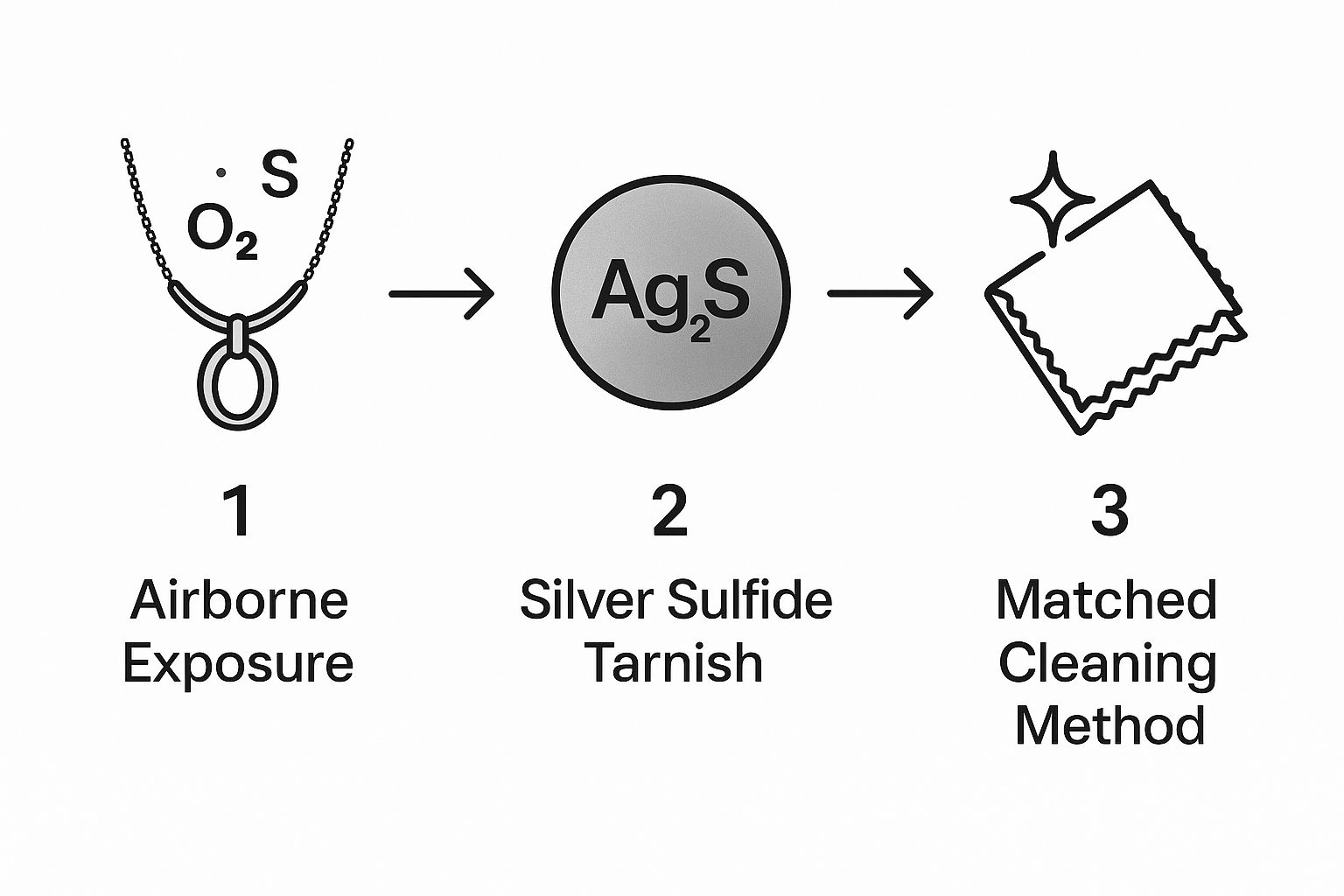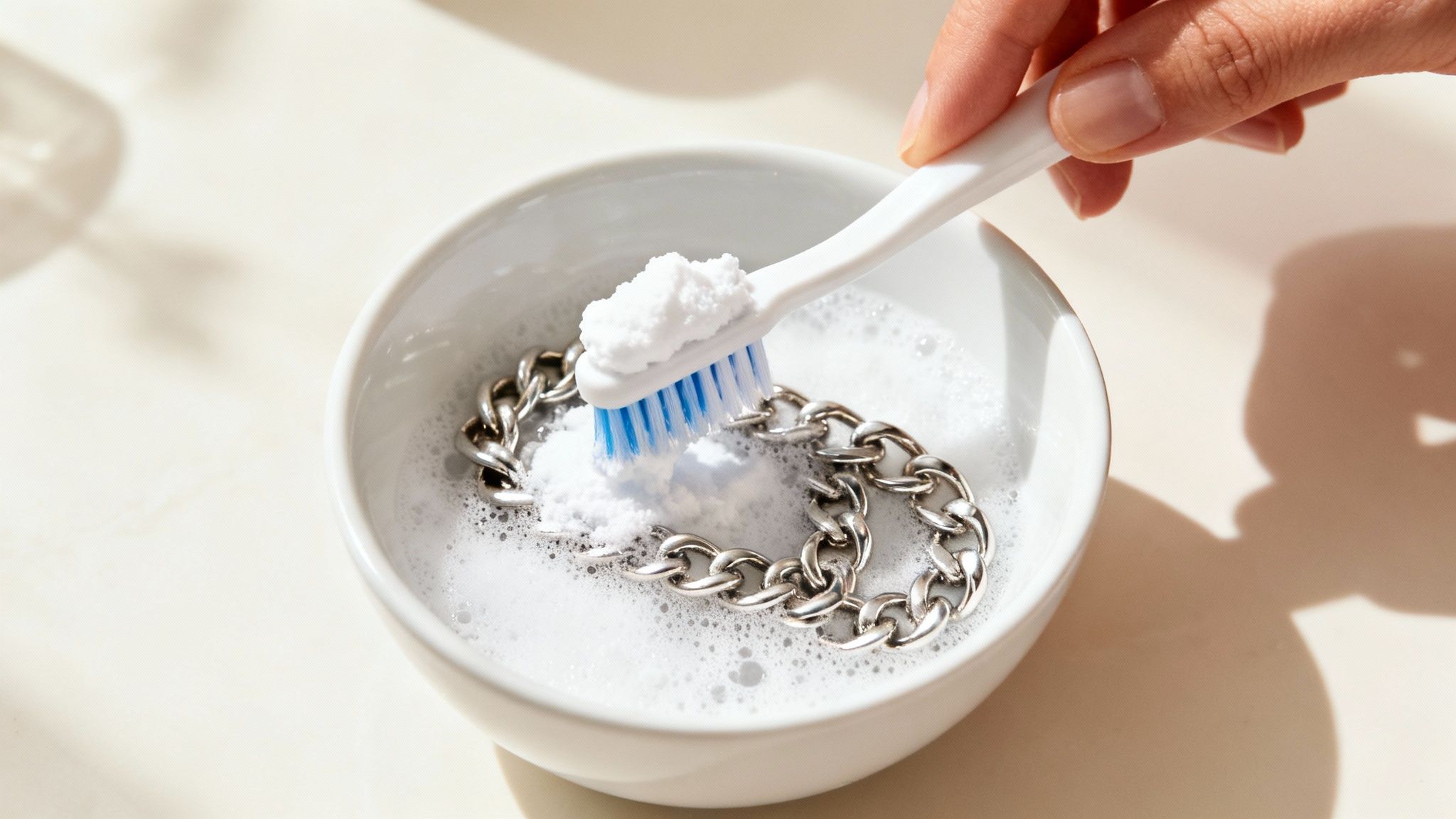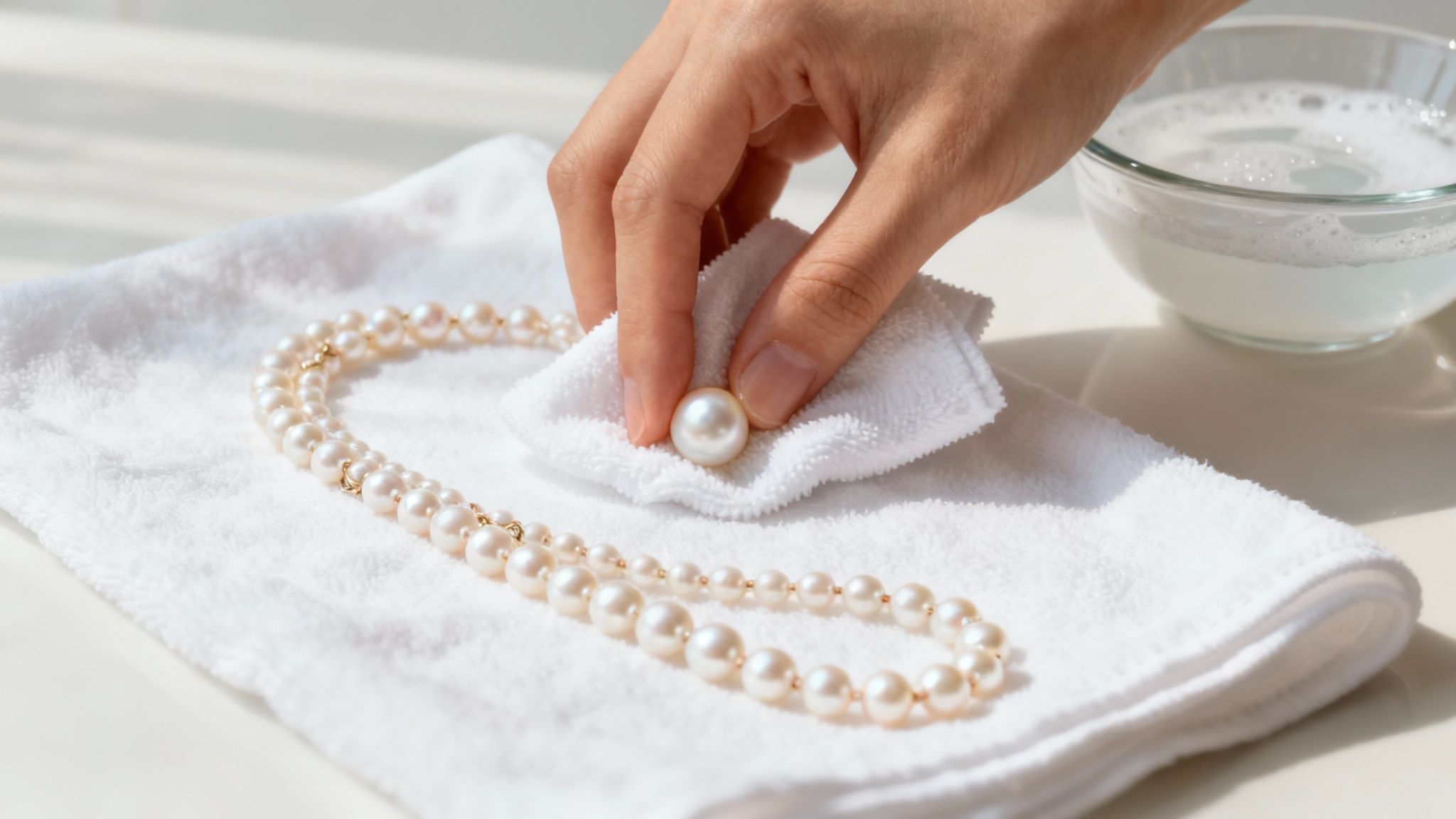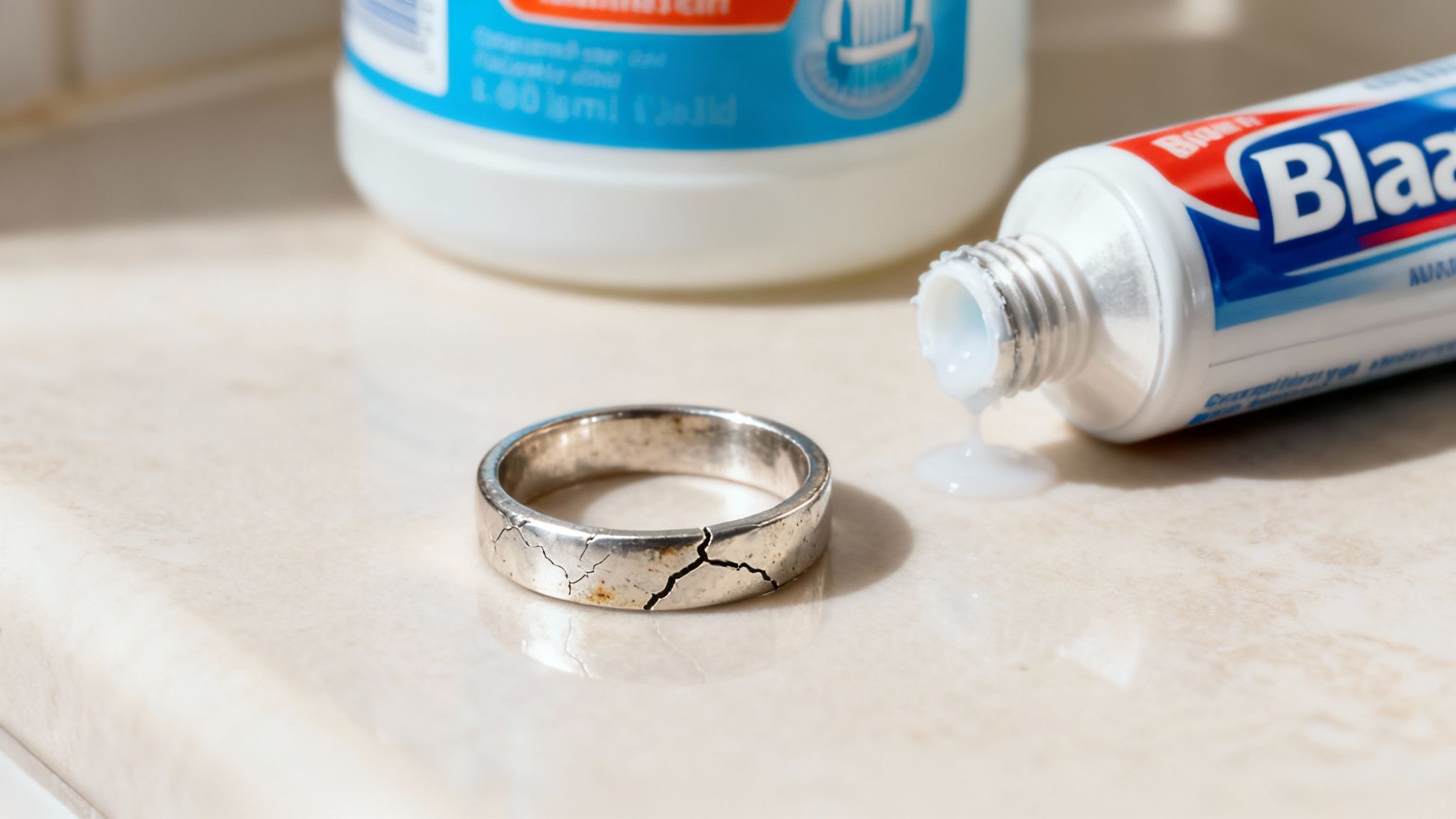Arthur Lynch | Fri Oct 17 2025
How to Clean Tarnished Jewelry and Restore Its Shine
Wondering how to clean that tarnished piece of jewelry you love? The best approach depends on the material. For light tarnish, a simple mix of mild soap and water often does the trick. But for stubborn cases on sterling silver, a paste of baking soda and water is a classic for a reason. The key is to always match your cleaning method to the jewelry's metal and any gemstones to avoid causing damage.
Why Your Favorite Jewelry Loses Its Sparkle
That beautiful sterling silver necklace or those trendy stacked rings didn't lose their shine because they're poor quality. The real culprit is basic chemistry. When metals like silver and copper are exposed to sulfur compounds in the air, a chemical reaction happens, creating that dark, dull layer we call tarnish. It's an unavoidable process, especially for the pieces you wear all the time.
This is a huge deal in the global jewelry market, which was valued at over $230 billion back in 2021. A significant chunk of jewelry maintenance is all about reversing this exact chemical reaction. In fact, an estimated 85–90% of silver jewelry starts showing tarnish within just six months to two years of regular wear. You can read more about the science of jewelry cleaning on Wikipedia.
The Science Behind the Tarnish
Figuring out why your jewelry tarnishes is the first step to cleaning it effectively. It’s not just about appearances; it's a chemical change happening on the surface of your favorite pieces. This isn't just dirt that you can wipe away.
This visual guide gives a great breakdown of how elements in the air cause tarnish and how the right cleaning method can reverse the process.

The main takeaway is that you're dealing with a chemical change, not just grime. That’s why a simple wipe-down doesn't work. To get a deeper understanding of this process, our guide on whether sterling silver tarnishes is a fantastic resource.
Global Trends and Jewelry Care
Jewelry styles are always changing, and what's popular around the world affects how we need to care for our collections. Think about the delicate, layered chains seen everywhere from Seoul to Paris, or the bold, chunky silver pieces that are so popular in North American markets. Each style comes with its own cleaning challenges.
Understanding the 'why' behind tarnish transforms how you approach the 'how' of cleaning. It shifts your focus from aggressive scrubbing to targeted chemical removal, preserving the integrity of your jewelry for years to come.
For example, different styles need different approaches:
- Layered Necklaces: This global trend features fine chains that tangle easily. Tarnish loves to build up in those tiny links, which is where a super-soft brush becomes your best friend during cleaning.
- Statement Silver Cuffs: Common in Southwestern US fashion and gaining popularity in bohemian European styles, these bigger pieces have more surface area exposed to the air, so they often tarnish much faster.
- Mixed-Metal Designs: A key trend from European fashion weeks is mixing gold and silver. This requires a careful cleaning strategy, since a method safe for one metal might be harmful to another.
To make things simpler, I've put together a quick-reference table. It matches common jewelry materials with the safest and most effective DIY cleaning methods, so you can choose the right approach every time.
Quick Guide to Cleaning Methods by Jewelry Type
| Jewelry Material | Safest DIY Method | Method to Avoid | Best For |
|---|---|---|---|
| Sterling Silver | Baking soda & water paste | Toothpaste, harsh chemicals | Removing heavy tarnish |
| Gold & Gold-Plated | Mild dish soap & warm water | Abrasives, chlorine bleach | Routine, gentle cleaning |
| Pearls & Opals | Damp, soft cloth only | Soaking, ultrasonic cleaners | Porous, delicate stones |
| Diamonds & Hard Gems | Ammonia & water solution | Abrasive scrubs, bleach | Restoring sparkle to durable stones |
This table should help you quickly identify the best way to care for your specific pieces without risking damage. Happy cleaning
Gentle At-Home Cleaning Methods for Everyday Pieces

You don't need a professional kit to bring your everyday jewelry back to life. In fact, some of the best solutions for cleaning tarnish are probably sitting in your kitchen pantry right now. The real secret isn't just knowing what to use, but matching the right recipe to the right metal. This way, you restore that beautiful shine without accidentally causing damage.
For example, the delicate, layered sterling silver chains trending in South Korea and Japan can trap tarnish in tiny links. In contrast, a bold silver bangle, popular in Scandinavian design, shows dullness across its large, smooth surface. Each piece needs a slightly different touch.
The Ideal Paste for Sterling Silver
Sterling silver is a relatively soft metal, so it needs a gentle but firm hand. A simple paste made from baking soda and water is a classic for a reason—it just works. The trick is getting the consistency right. You're aiming for a thick paste, something more like toothpaste than a watery solution.
A good rule of thumb is a ratio of three parts baking soda to one part water. This creates a fantastic, non-abrasive polish that lifts tarnish right off the surface.
You’d be surprised how many people already do this. Consumer surveys show that nearly 70% of jewelry owners try cleaning tarnished pieces at home, and baking soda is the go-to for silver. It's not just an old wives' tale, either; lab tests have shown this simple paste can remove 60–80% of surface tarnish after just a few minutes of gentle rubbing. For more tips on this, you can learn about green cleaning for jewelry from Westpack's blog.
A Simple Soak for Solid Gold
Solid gold doesn't tarnish like silver, but it definitely gets dirty. Over time, daily exposure to skin oils, lotions, and dust will dull its famous luster. The best way to bring it back is a simple, mild bath.
- The Perfect Ratio: Just add a few drops of a gentle, phosphate-free dish soap to a bowl of warm water. Never use hot water, as sudden temperature changes can damage certain gemstones or settings.
- The Gentle Scrub: Let your gold pieces soak for about 15-20 minutes. Then, use a brand-new, baby-soft toothbrush to carefully clean around settings and get into any crevices.
- The Final Rinse: This is a step people often forget. Always rinse your jewelry thoroughly under cool, running water to get rid of any soap residue, which can leave a dull film behind.
The most crucial tool in your DIY cleaning arsenal is patience. Gentle, repeated motions with a soft material will always yield better—and safer—results than aggressive scrubbing with a harsh one.
Once you’re done cleaning, drying your jewelry properly is essential. Pat each piece completely dry with a soft, lint-free cloth, like a microfiber towel or a dedicated jewelry polishing cloth. This final step prevents water spots from forming and leaves you with that brilliant, just-like-new shine.
Safely Cleaning Jewelry with Gemstones and Pearls

When your favorite pieces feature gemstones or pearls, you have to completely rethink your cleaning strategy. The methods that work so well on plain silver or gold can do some serious, irreversible damage to these more delicate materials.
What’s safe for a diamond can absolutely destroy an opal or a string of pearls. It all comes down to knowing the difference between hard, resilient stones and their soft, porous counterparts. Once you know what you’re working with, you can get that sparkle back without any risk.
Care for Hard and Durable Stones
Let's start with the tough ones. Stones like diamonds, sapphires, and rubies are incredibly durable, which means they can handle a more hands-on cleaning. This is great news, because it lets you get into all the nooks and crannies where dirt and lotion build up, dulling their fire.
For these sturdy gems, I always go back to a tried-and-true method:
- Grab a small bowl of warm water and add just a few drops of a gentle dish soap.
- Let your jewelry soak for about 15-20 minutes. This does most of the work for you by loosening all that grime.
- Next, take an ultra-soft toothbrush (a baby toothbrush works perfectly) and give it a gentle scrub, focusing on the settings and underneath the stone.
- Rinse it well under cool, running water and pat it completely dry with a soft, lint-free cloth.
This simple soak-and-scrub is fantastic for making an engagement ring or a pair of sapphire studs look brand new. A word of caution, though: stay away from cleaners containing ammonia unless you're absolutely positive the stone and its setting can take it.
Cleaning Soft and Porous Gems
Now for the delicate flowers of the jewelry world. You have to be extremely careful with pearls, opals, turquoise, and emeralds. These gems are porous, meaning they can literally absorb liquids and chemicals, which can cause them to discolor, dry out, or even crack.
The golden rule I always tell people is to treat pearls and other soft gems like you'd treat your own skin. No harsh chemicals, no soaking, and absolutely no ultrasonic cleaners. These can permanently ruin their beautiful, unique luster.
The best and safest approach is to simply wipe them with a soft, damp cloth right after you wear them. If they need a little more help, dampen a cloth with water and the tiniest speck of mild soap, wipe the piece, and then immediately follow up with a second cloth that's just damp with plain water.
The key is to never submerge them. This gentle touch is all they need to stay beautiful, a cleaning philosophy that holds true whether you're caring for classic heirlooms or trendy, organic-style pieces popular in Latin American and Mediterranean fashion.
Common Cleaning Mistakes That Ruin Your Jewelry

Sometimes, the best way to learn how to clean tarnished jewelry is to first learn what not to do. It’s a hard lesson to learn, but using the wrong technique can cause far more harm than the tarnish itself, often leading to expensive repairs or permanent damage.
Many of those popular DIY cleaning hacks you see online can strip plating, scratch soft metals, or completely dull a gemstone’s fire. The biggest mistake I see is people treating all their jewelry the same. What works perfectly for a solid gold ring could be a disaster for a plated piece. If you're unsure, it’s always better to know the specifics, which is why we put together this detailed guide on caring for gold-plated jewelry.
The Danger of Harsh Abrasives and Chemicals
When you see tarnish, it’s tempting to reach for a powerful household cleaner you have under the sink. Please don’t. Harsh chemicals like bleach or ammonia can cause pitting and permanent discoloration, especially on silver.
Another big one to avoid is toothpaste. I know, it's a popular "life hack," but it's a terrible idea for your jewelry.
Toothpaste is designed to scrub tough tooth enamel, not soft precious metals. Its abrasive particles will create thousands of micro-scratches on your jewelry’s surface, permanently dulling its shine and finish over time.
This isn’t just a minor cosmetic issue. According to conservation experts, an estimated 5–8% of antique jewelry brought in for appraisal shows signs of damage from improper cleaning. Silver is particularly susceptible; between 1995 and 2020, a staggering 18% of silver items in museum collections showed etching from harsh cleaning agents. For more on this, the Canadian Conservation Institute has some great insights on silver care.
Misusing Ultrasonic Cleaners at Home
Ultrasonic cleaners can feel like magic—a professional-level clean right on your countertop. But that power can be destructive if you don’t know what you’re doing. The high-frequency vibrations that knock dirt loose can also shake delicate gemstones right out of their settings.
Here’s a quick list of what should never go into an ultrasonic cleaner:
- Porous Stones: Things like pearls, opals, coral, and turquoise are too soft and absorbent. They can be easily damaged.
- Treated Gems: Many emeralds are fracture-filled to enhance their clarity. The vibrations can easily damage or remove these treatments.
- Antique Pieces: Older jewelry often has fragile, delicate settings that just can't stand up to the intense vibrations.
When in doubt, always double-check if your specific piece of jewelry is safe for an ultrasonic bath before you turn it on.
Proactive Care to Keep Your Jewelry Sparkling
Let's be honest, the best way to deal with tarnish is to prevent it from happening in the first place. While it's great to know how to clean your jewelry, a little proactive care means you’ll be doing it a lot less often. Making a few small tweaks to your daily routine can make a world of difference.
Think about those delicate, layered necklaces that are a global trend. Their tiny links are magnets for tangles and tarnish. By taking them off before bed, you’re not only preventing knots but also limiting their exposure to your skin's natural oils. The same goes for those bold, mixed-metal statement pieces you see in European fashion—proper care is what keeps the unique finish of each metal looking sharp.
Smart Storage and Daily Habits
When it comes to your jewelry, the biggest culprits behind tarnish are moisture, air, and chemicals. How you store your pieces has a massive impact on how quickly they start to dull. Tossing them onto a nightstand is an open invitation for all three to do their worst.
The single best piece of advice I can give is to follow the "last on, first off" rule. Your jewelry should be the very last thing you put on—after lotions, perfumes, and hairspray—and the first thing you take off before swimming, showering, or working out.
Ready to protect your favorite pieces? Start with these simple habits:
-
Give Them Space: Store jewelry so that individual items aren't touching. This is key to preventing harder stones like diamonds from scratching softer metals or gems.
-
Fight Tarnish Directly: Use a jewelry box with an anti-tarnish lining, wrap pieces in a special cloth, or even store them in small, individual ziplock bags. These small steps dramatically slow down the oxidation that causes tarnish.
-
Keep It High and Dry: Always find a cool, dry spot for your collection. The bathroom is one of the worst places you can leave jewelry because of the constant humidity.
Putting these simple strategies into play will keep your collection sparkling for years to come. For an even deeper dive, check out our professional tips on jewelry storage and organization to build the perfect system for your needs.
Answering Your Top Jewelry Cleaning Questions
When it comes to caring for your jewelry, a few questions pop up time and time again. Getting these answers right is key to keeping your favorite pieces looking their best and avoiding any cleaning mishaps.
How Often Should I Clean My Jewelry?
Honestly, there's no single answer here—it all comes down to what you're wearing and how often you're wearing it. That sterling silver ring you never take off? It’s probably a good idea to give it a gentle clean every couple of weeks to deal with the buildup of lotions, soaps, and natural skin oils.
On the other hand, a gold necklace you only wear for special occasions might just need a touch-up once or twice a year. Pieces that see a lot of action, like bracelets, will naturally need more attention than items that don't come into as much contact with surfaces.
A common mistake is thinking all jewelry needs the same cleaning schedule. The secret to long-term shine is tailoring your routine to the specific metal and how often you wear it.
Can I Use Toothpaste to Clean Silver?
This is a big one, and the short answer is no. It’s an old myth that, unfortunately, does more harm than good. Toothpaste is designed to be abrasive enough to scrub enamel, and those same gritty particles will leave thousands of tiny, permanent scratches all over the surface of a soft metal like silver. Over time, this actually makes your jewelry look dull. It's much better to stick with a method designed for your precious metals.
Are Ultrasonic Cleaners a Safe Bet?
Ultrasonic cleaners can be a game-changer for the right kind of jewelry, but they can be downright destructive for others. They work wonders on hard, non-porous pieces—think solid gold, platinum, and diamonds.
But you should never put soft or porous gemstones in one. The intense vibrations can easily crack or even shatter delicate stones like pearls, opals, emeralds, and turquoise. You also run the risk of shaking stones loose from older, more delicate settings. When in doubt, clean those pieces by hand.
Ready to add some new sparkle to your collection? Check out the incredible, on-trend selection at JewelryBuyDirect. With prices straight from the factory and new styles added daily, you’re bound to find something you love. Visit JewelryBuyDirect today!

 to show code
to show code






































































































































































